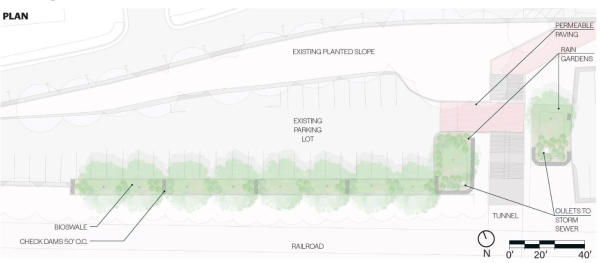Photo by Marc Hall
By Cailyn Kennedy
CCEE students and alumni may remember being stopped in their tracks on a rainy day by the flooded Reynolds-Mann tunnel — a high-traffic pathway connecting NC State’s north and central campuses that runs under a stretch of railroad tracks. You stand there, deciding whether it is worth it to wade through the shin-deep water, take the long way, or turn around and skip class for the day. If only there was a better way.
The NC State Sustainability Stewards have partnered with the Department of Landscape Architecture and Environmental Planning to work on a proposed design for the U.S. Environmental Protection Agency (EPA)’s Campus RainWorks Challenge. Their design primarily focuses on mitigating the amount of water going into the tunnel from the large parking lot on the northwest side of the tunnel.
The team, which include CCEE students Tana Harris, Elias Zauscher, and Vie Villafuerte (as well as other NC State students Benjamin Helms, Connor Hoke, Emma Wilson, Kyle Wurtz, Alie Akins, and Emily Applegate), conducted a survey that showed 13.3% of NC State students turn around and skip class when they encounter a flooded tunnel on campus. Over time, this results in missed learning opportunities.
To address this problem, the team, advised by Grant Livengood of McKim & Creed, NC State Facilities Advisor Thomas Skolnicki and CCEE’s Dr. Jonathan Miller, created a project titled “Bioswales by the Rails” as part of the U.S. Environmental Protection Agency (EPA)’s Campus RainWorks Challenge. The 10th annual competition challenged university teams from across the nation to create a design to manage stormwater in their local area using green infrastructure techniques, such as rain gardens and bioretention areas.

The team has proposed a 200-foot bioswale to capture the majority of the stormwater that runs along the edge of the parking lot bordering the railroad tracks. The planned bioswale is a channel full of native plants that helps to reduce the flow rate and capture pollutants from runoff. At the end of the bioswale, there will be a rain garden positioned to capture the remaining water instead of allowing it to flow into the tunnel. Over 10 years, the project could save more than 40,000 student class hours that would otherwise be lost to flooding issues.
“What I enjoyed the most about this project is that I was able to apply concepts such as hydraulics, storm water systems, and green infrastructure that I had learned in my environmental engineering classes,” says environmental engineering student Vie Villafuerte.
Civil engineering student Tana Harris says the RainWorks project gave her an “inspiring perspective” of what it will be like to work as an engineer after graduation.
The NC State project tackles six major goals: flood mitigation through green infrastructure, supporting NC State’s Sustainability Strategic Plan, improving water quality in Raleigh, student quality of life and safety, campus education and inspiring future generations, and campus aesthetics. With all of the different aspects of this design project, the team had to bring together engineering students from a broad range of concentrations.

“Our mixed team of disciplines — including students from nuclear engineering, computer science, civil engineering, environmental engineering, and landscape architecture — gave interesting perspectives and allowed us to learn a lot from each other as we collaborated and tackled the problems incorporated in the project,” Harris says.
Winners of the EPA competition will be announced in April. Project advisor Dr. Jonathan Miller says the team “hopes to see their plan come to life during their time here at NC State,” pending approval from the campus facilities department and funding.

